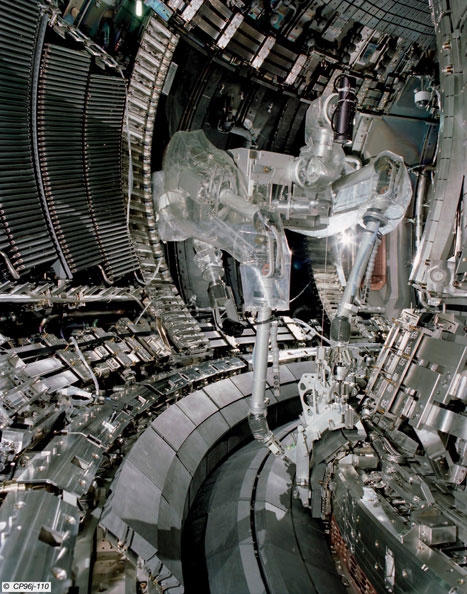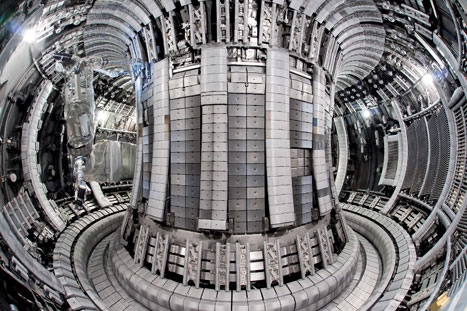The world’s largest nuclear-fusion experiment has a new lease of life. Joint European Torus (JET), at the Culham Science Centre near Oxford, has restarted after an 18-month shutdown to replace the entire reactor lining and is now collecting data that will be vital to the construction and operation of its successor, ITER, currently being built in southern France.

ITER - the name is not an abbreviation, but is Latin for ’next’ - is intended to be the first fusion reactor to achieve self-sustaining operation and to generate net energy; that is, more energy than it takes to operate it. Like JET, it will be a tokamak: a toroidal (doughnut-shaped) vessel that constrains a plasma made from hydrogen atoms using powerful magnetic fields, while heating it by pumping in microwaves, pushing an electric current around the ring and injecting fast streams of more hydrogen atoms. Eventually, the magnetic pressure and the heat overcome the tendency of the hydrogen nuclei in the plasma - which have the same electric charge - to repel each other and they are forced together to form helium nuclei, releasing a burst of energy and a high-energy neutron.
Known as magnetic confinement, this is one of two forms of fusion currently being attempted around the world as part of the effort to determine whether fusion can ever be a practical way of generating electricity. JET is the only tokamak in the world capable of handling tritium, the radioactive form of hydrogen with two neutrons in its nucleus, which is essential to fusion, as it joins with the single-neutron-form deuterium to form a helium nucleus. It has achieved this target several times, but there are still several technical stumbling blocks between JET and ITER.
“The first pulse we tried went straight to 1MA and lasted 15 seconds - we were stunned”
One of these, until recently, was the reactor lining. Like most of the world’s tokamaks, JET was lined with tiles of carbon-fibre composite. However, this lining would have been useless - in fact, catastrophic - for ITER.
Carbon is a good lining for small experimental tokamaks, explained Guy Matthews, director of the ’ITER-like wall’ project at JET. The conditions inside a functioning tokamak where fusion is occurring will erode the reactor lining, chipping atoms off the inner wall and flinging them into the plasma. ’Plasmas prefer to have low atomic-number impurities; that is, atoms with not too many electrons,’ Matthews explained. ’When an atom goes into the plasma and becomes fully ionised, the electrons dilute the plasma - each electron displaces a deuterium or tritium atom.’
Carbon was a good choice because of its low atomic number - it has six electrons - and the resilience of graphite to high temperatures. But when tritium is involved, problems start because of the complex chemistry of carbon. The carbon atoms released into the plasma react with hydrogen to form hydrocarbons, which build up in deposits on the reactor wall. When the form of hydrogen available includes tritium, these hydrocarbons are radioactive. ’You build up a tritium inventory, trapping it in the wall of the machine, and it becomes a radiological issue, a safety issue and an economic issue; tritium supply is limited. And you’d have to develop a method of removing it from the walls,’ Matthews said.

This wasn’t a problem in JET, because of its relatively small size (about 2m across) and the short duration of its plasma pulses (generally a few tens of seconds), so hydrocarbon build-up was small. But ITER and successive generation-scale tokamaks will be 10 times the size and operate for much longer, with a typical ITER pulse lasting for about 15 minutes. With JET’s status as the only practical test bed for ITER technology, it fell to the team there to develop and test a new plasma-facing wall.
The choice of materials is rather limited, Matthews said. ’If you want to avoid the carbon chemistry, you have to look at the low end of the periodic table. But most of the metals have low melting points and aren’t much use for engineering. Even aluminium, which is a bit heavier than you’d want, melts at 600°C. But then you look at beryllium and that’s exceptional.’
Beryllium is probably the lightest engineering material. Melting at 1,300°C, it is lighter than aluminium and stiffer than steel, and is already used in highly specialised engineering applications, mainly in space and defence; for example, the primary mirrors for the James Webb Space Telescope are made of beryllium. ’There’s a specialist beryllium engineering industry; it’s not big but it’s there,’ Matthews said. ’There are a handful of companies in Europe and a few in the US, mainly dealing with alloys such as beryllium-copper, but also using the pure metal.
As it happens, JET has experience in using beryllium. The first director of the facility, Paul-Henri Rebut, commissioned some beryllium plasma-facing components in its early days and Culham had a stockpile of about four tonnes of pure metal. This, Matthews said, was just enough for the new lining.
Beryllium is a difficult metal to work. As well as being hazardous, it is very brittle, which isn’t conducive to the inside of a fusion reactor, where it will be subjected to many cycles of heating and cooling; this generates stresses inside the material, which can lead to cracking. To avoid this, the beryllium tiles are precisely machined. They are scored with deep lines in a grid pattern, which prevents the stress build-up, and have angled faces so the heat of the plasma can’t impinge directly onto the surface. ’Because we have pulses of tens of seconds, the heat capacity of the metal is sufficient to absorb the energy and conduct it into the reactor shell,’ Matthews said. ’The tiles in ITER would have to be different, with an active cooling system incorporated into their structure. We could have done that, but it would have been vastly more complicated and expensive.’
The only part of the reactor not lined with beryllium is a trench around the base of the torus known as the diverter, where the particles in the plasma interact directly with the wall and lose their energy. This region is lined with tungsten tiles, as the higher atomic weight of the metal prevents atoms from being dislodged when light helium nuclei collide with them.
Carbon was a good choice because of its low atomic number, but problems start when tritium is involved
The replacement of the lining had to be carried out all in one go, because any carbon present inside the reactor would quickly coat the surface and render the beryllium useless, Matthews explained. The process took 18 months and was mostly carried out using remote-handling equipment, because neutron bombardment had rendered the outer shell of the reactor radioactive. ’It’s certainly the largest remote-handling job that’s ever been done in fusion,’ he added.
Since JET restarted, the effect of the new wall has been dramatic, Matthews said. ’Normally, it’s a bit of a struggle to get the first plasmas to run properly. JET only holds 0.1g of plasma and we don’t need much impurity to mess it up; it takes a while to build up to a mega-amp of power or so. But the first pulse we tried went to 1MA immediately and lasted about 15 seconds, partly because the beryllium also helps clean the vacuum inside the reactor; it cleans oxygen out of the system. We were really quite stunned.’
In Depth: Laser Fusion
Laser fusion is another possibility for energy generation, but could potentially lead to a range of engineering problems
While the other form of fusion under study, laser-fired or inertial-confinement fusion, doesn’t require the management of a plasma, the beryllium wall of JET will still provide valuable insights, Guy Matthews said.
Laser-fired fusion works by forcing a tiny capsule containing deuterium and tritium to implode by hitting it with lasers from all sides, within a vacuum vessel. The pressure wave crushes the fuel and leads to fusion. The most advanced experiment, at the National Ignition Facility in California, is scheduled to attain net energy from fusion within 18 months. But, according to Matthews, the technique still needs plasma-facing components.
’They have an explosion with a heat pulse and debris, and that’s going to interact with the walls of the chamber with erosion, deposition and so on. A working fusion reactor will need to run 10 explosions per second and achieve a vacuum within the vessel before each one. There’s no doubt that there will be a lot of similar engineering problems to the ones we’re tackling.’




Red Bull makes hydrogen fuel cell play with AVL
Formula 1 is an anachronistic anomaly where its only cutting edge is in engine development. The rules prohibit any real innovation and there would be...